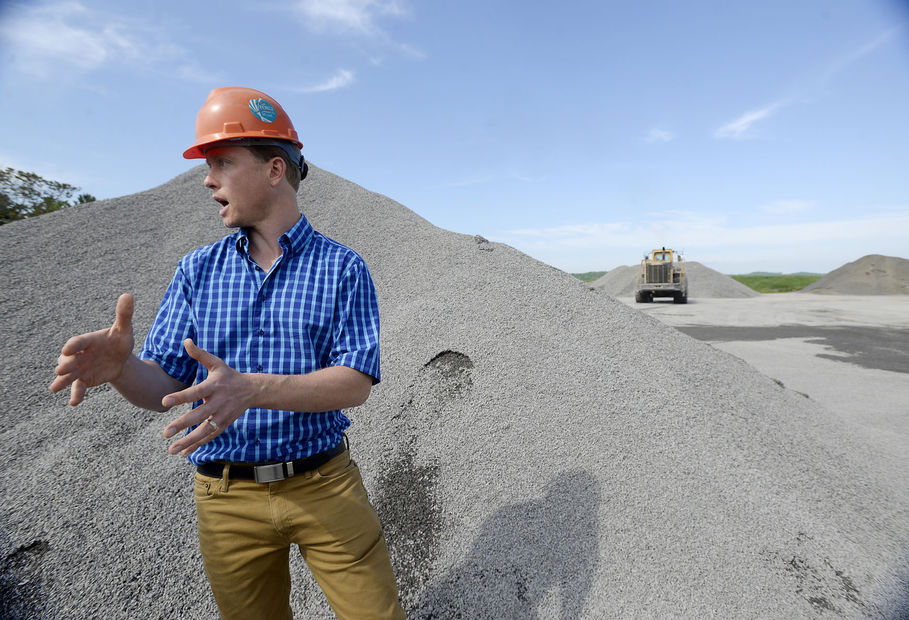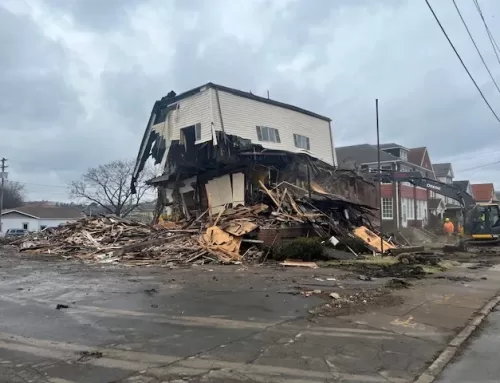Article written by: By Eric Poole epoole@ellwoodcityledger.com /// Click here to read original
WAYNE TWP. — Almost knee-deep in a field of alfalfa and clover, Fred Cardillo — a farmer who supplements his income by blowing up stuff, or an explosives expert who supplements his income by farming — looks around and makes a pronouncement.
“I could bale this.”
That statement is rather more extraordinary than it sounds, considering that the field was an open-pit mine at this time last year. But Cardillo said the field, part of the Amerikohl Aggregates McMillin limestone mine off Chewton-Wurtemburg Road in Wayne Township, is ready to be used once again for farming.

Amerikohl Vice President Jamie Stilley, stands near a pile of crushed limestone at the McMillin site on Friday in Wayne Township. Another surface mining operation is under way near Ellport in Wayne Township.
Amerikohl is in its fourth year extracting limestone from the McMillin Mine, with about another five years to go, company Vice President Jamie Stilley said. Almost four miles away, as the crow flies, the company is beginning work on another operation, the Gardner Mine, on the hill across Connoquenessing Creek from Ellport.
Work at the McMillin site is a model — including appearance — for what will happen at the Gardner Mine, Stilley said. That includes restoration, which is going along at an accelerated pace. Only a year after completing mining at part of the McMillin Mine, the property owners were bailing alfalfa.
“It’s kind of unprecedented, that they are farming here,” Stilley said. “We’re proud of that.”
Extraction: Limestone in focus
Amerikohl was founded more than 30 years ago by Stilley’s father, John, primarily as a coal-mining company, and still extracts coal, mostly for electric plants, according to the company website.
But as environmental regulations are driving coal-fired power plants out of business and decreasing demand for the resource, the company has diversified. The company has offices in Butler Township, Butler County, and Stahlstown, Westmoreland County. Jamie Stilley’s brother, Jake, runs Patriot Exploration, Amerikohl’s natural gas development arm.
For the past few years, Jamie Stilley’s main focus has been limestone mines. He oversees operations at both of the Wayne Township sites, and at the Jim Mountain Quarry, in Mill Run, Fayette County.
The two Wayne Township mines are part of the Vanport limestone seam, which covers an area just north of Pittsburgh in eastern Ohio and western Pennsylvania into Armstrong County. The Mill Run mine is along the Loyalhanna seam.
Limestone is a sedimentary rock, formed by the bones and shells of ancient marine animals. In western Pennsylvania, most limestone is about 30 feet below the surface and a vein of the mineral can be about 20 feet thick.
A cubic yard of Vanport limestone — named for the Beaver County borough of Vanport, according to the U.S. Geological Survey — can weigh more than 2 tons. A versatile mineral, limestone might have more uses than any other, according to geology.com.
Typically, limestone is used in construction — particularly on roads and bridges — to provide erosion barriers, and for the manufacture of cement. When finely ground, limestone can serve as anti-skid material.
Stilley said McMillin Mine limestone is being used at the rate of more than 1,800 tons a day for road base, bridge construction, and base for water and sewer lines used by government and private contractors, including the Pittsburgh International Airport.
Amerikohl’s current customers include Mekis Construction, which replaced the Second Street railroad overpass last year in Ellwood City. Bridge and infrastructure projects generate high demand for limestone, Stilley said
“There’s a rapid bridge replacement program in western Pennsylvania, and it’s really gobbling up the stone,” he said.
Boom: a sound of mining
About 3 p.m. Friday, May 20, Tracey Risko was in her house in Ellport, almost a half-mile from the Gardner Mine site, when she heard an explosion.
“I thought the floor was going to collapse,” she said.
Risko said she ran outside, where she saw neighbors who had heard the same explosion. From the hillside across Connoquenessing Creek, Risko said she could see a cloud of dirt.
The explosion was likely from the Gardner site, where Stilley said about 20 blasts have taken place as Amerikohl prepares the mine for extraction operations. Use of explosives in limestone mining is heavily regulated, said Cardillo, a South Fayette Township resident who works for Senex Explosives in Washington County.
When he isn’t working the farm in southwestern Allegheny County, Cardillo is a “shooter” in mining parlance. He sets off explosions when massive front loaders and bulldozers aren’t enough to move rock and soil. By his estimation, 20 different agencies oversee the work he does at a mine site.
When preparing a mine pit, heavy equipment operators scrape off the topsoil and preserve it for use in restoring the site. The remaining surface dirt — about 25 to 30 feet — is known as “overburden.” Like the top soil, it also is removed and preserved.
Mining with explosives is about energy — specifically, directing it properly — Cardillo said. If a blast is felt thousands of feet from the blast site, that’s a waste of energy.
“Energy will seek the path of least resistance,” he said. “If there’s a crack in the rock, that’s where it will go.”
Ideally, the blast will break up what needs to be broken up, and nothing else.
Companies performing blasts have to perform a geological survey to determine potential blast impacts and issue warnings in surrounding areas. In Ellport, one of those warnings has been a posting at Sheeler Playground.
When using explosives, mining companies are required to use seismographs for most blasts. But Cardillo said Amerikohl uses the devices, which measure underground movement in response to explosions, even when it doesn’t have to.
Cardillo doesn’t work directly for Amerikohl, but he’s one of its biggest boosters.
“They care for the employees, the environment, the neighbors and even the contractors,” Cardillo said of the company.
The operation
At the Gardner site, Amerikohl is completing work on its processing yard, a perimeter equipped with grinding devices and screens of varying sizes that produce limestone in the wide range of sizes necessary. The company processes and stores the stone for delivery by truck to customers.
Topsoil from the processing yard area is piled up around the grinding and screening machinery, with tall grasses planted, to serve as a noise barrier.
The screens separate processed stone by size, with the smallest stone — used for winter anti-skid material, fine road base and asphalt — falling to the bottom. Larger stone, which has such uses as heavy road base and erosion barriers, is held in the topmost screens.
While extraction at the the Gardner Mine has yet to begin, about 80 truckloads, each carrying about 23 tons of stone, leave the McMillin yard each day. Stilley said the Gardner mine is expected to match that production level.
Both the Gardner and McMillin sites cover about 200 acres, and Amerikohl workers go across the leased property in stages, one pit at a time. When one pit is completed, the workers start another a short distance away.
“At all times, we have a limited footprint,” Stilley said. “We fill in the last hole with the next hole.”
When work on the site is completed, workers use the first hole, including the top soil, to fill in the last hole.
The rules
Except for the active pit and processing yard, the McMillin site displays no evidence of mine activity. Under federal law, mining companies have to restore all work sites to the pre-mining conditions.
Stilley said the permitting process, including permission to use explosives, was a two-year process before they could even begin moving dirt at either location, and Amerikohl will be responsible for the site for five years after shutting down operations.
Those rules include maintaining detention ponds, to ensure that no mine runoff water reaches waterways until it has been tested and treated. Mining companies also have to test air quality and stone quality. Tests are performed both on site, at a laboratory next to the administration trailer, and off site by independent agencies.
Stilley said the most important regulatory issue might be restoring properties, and not just because it’s the law.
As a mining company executive, he’s become something of an expert on plants and how they affect the soil and facilitate restoration. Alfalfa and clover, for instance, help infuse soil with nitrogen and enable other plants to grow.
From a green hillside that was a barren mine pit only a year ago on the McMillin site, Stilley points to a nearby hill, across Vinegar Valley Road, where Amerikohl operated a surface coal mine less than a decade ago. Trees and natural vegetation cover the hill’s surface, as if the mine had never existed.
While he realizes that a wide range of federal agencies require him to restore the land to its previous glory, Stilley said it’s also good business.
Mining, whether it be for coal or limestone, depends to a great degree on convincing landowners to sign leases. And, Stilley said, it’s easier to get those farmers and rural property holders to sign off on a lease if they know the mining company will leave the land in the same condition in which they found it.
“We’re incentivized to do it regardless,” he said.







Leave A Comment